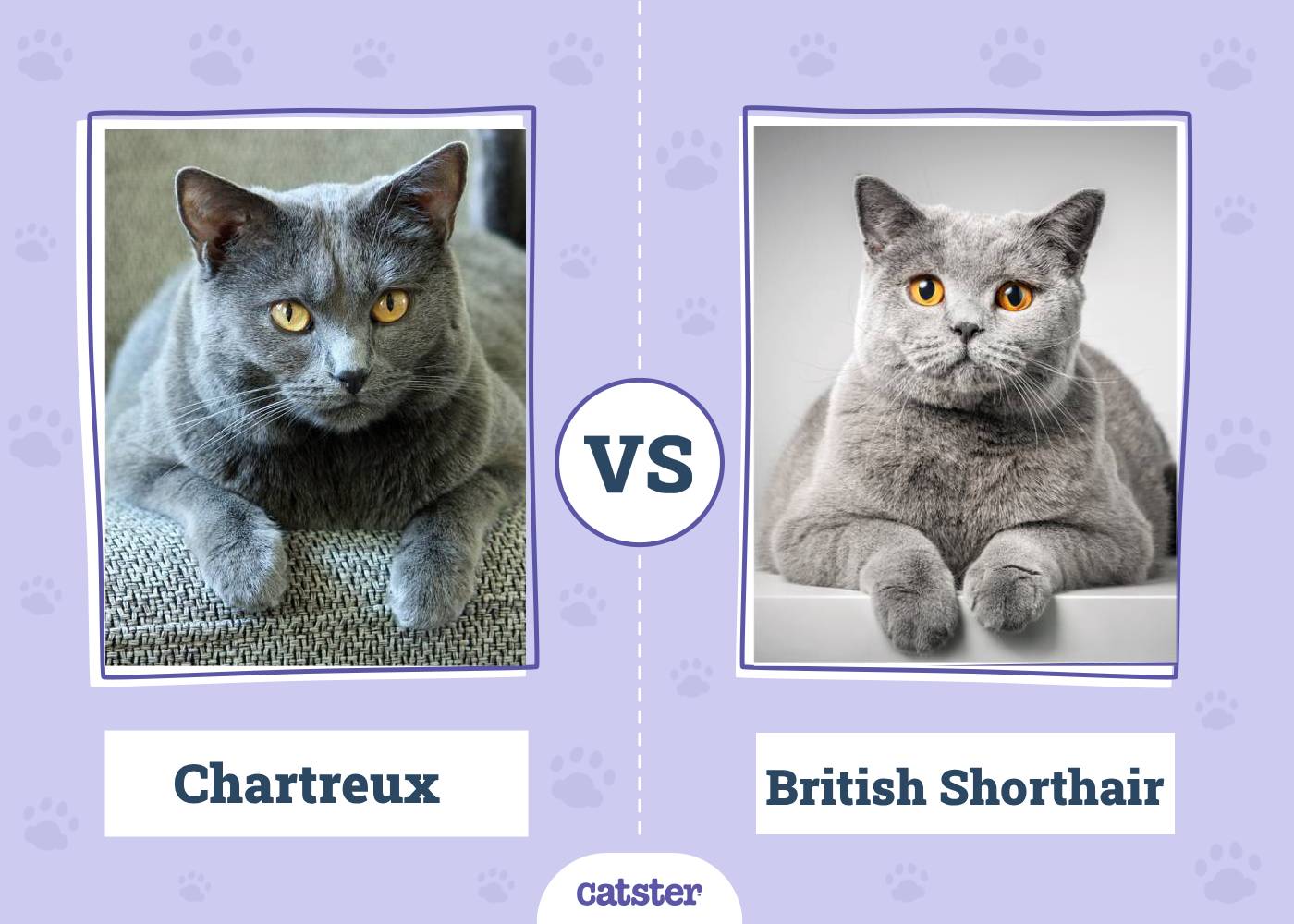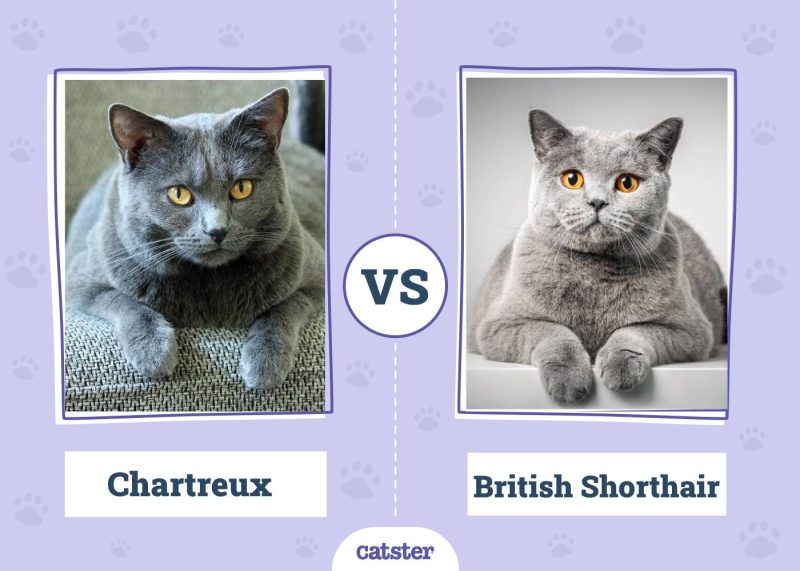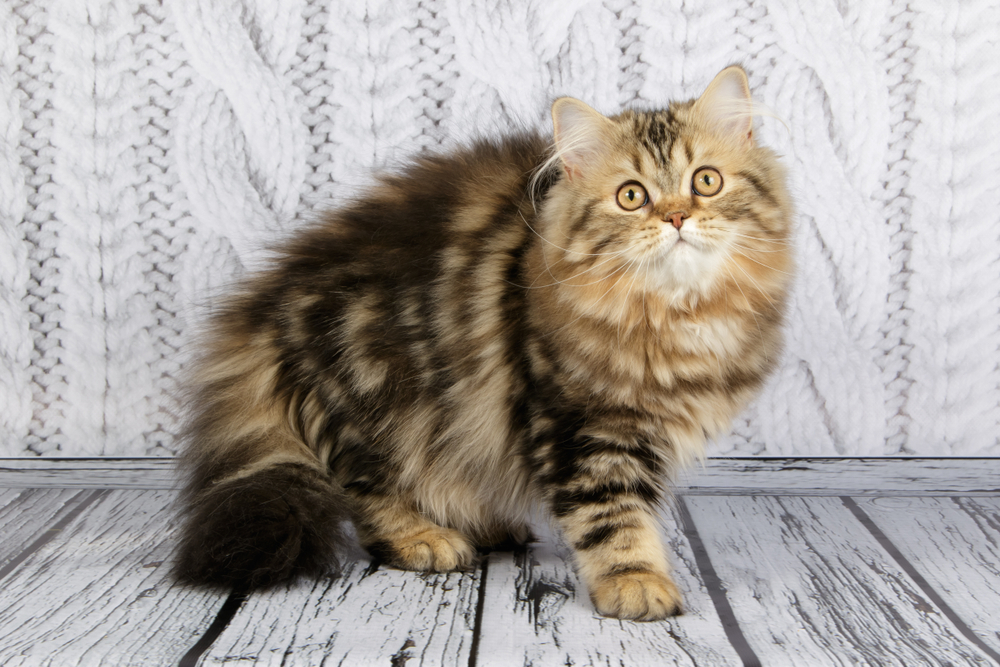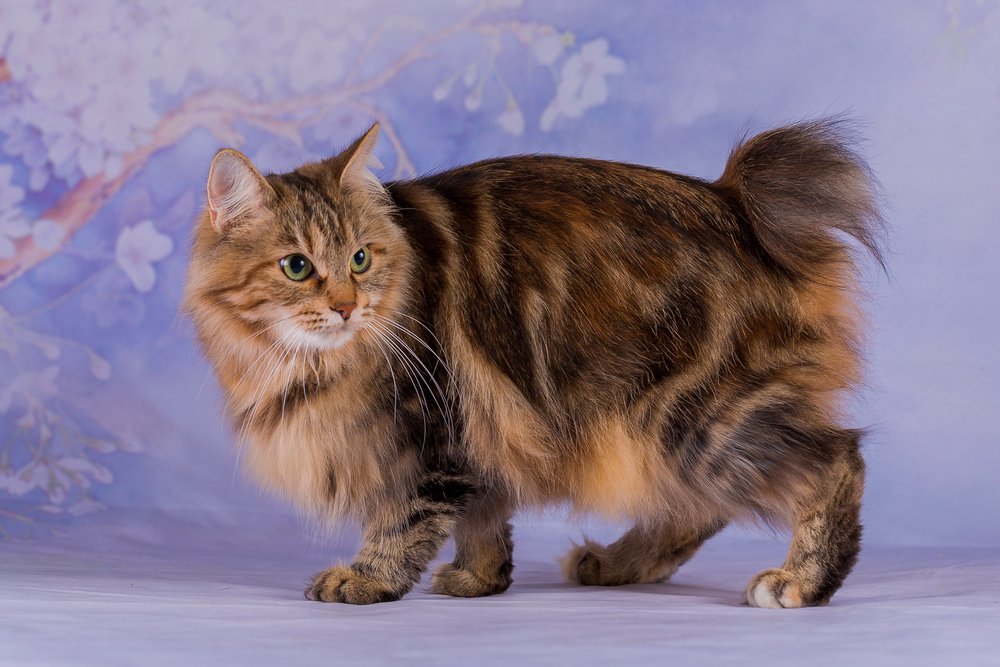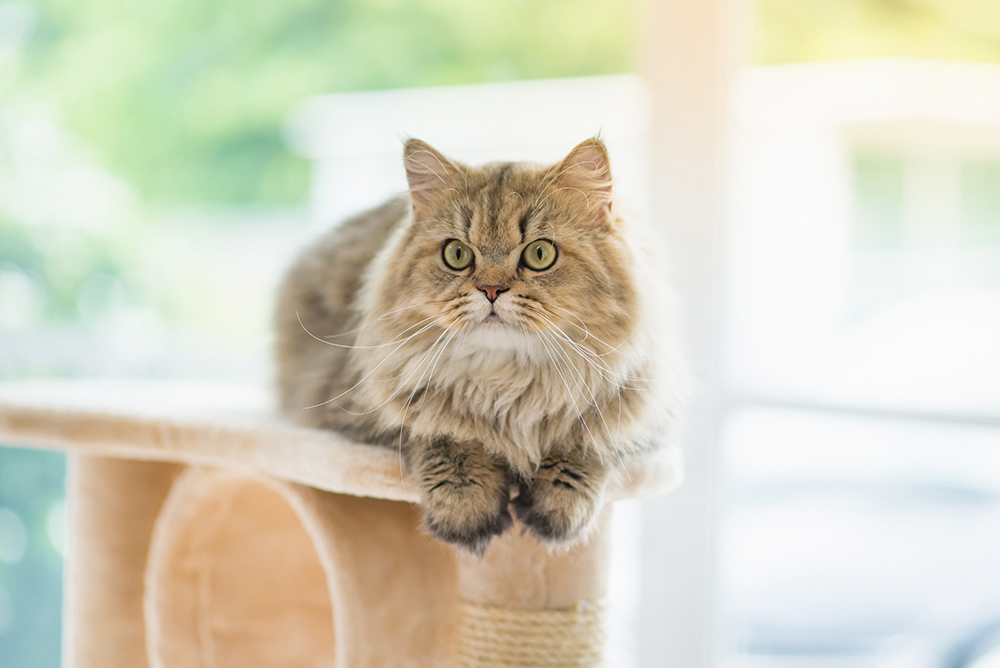Looking at photos of Chartreux and British Shorthairs cats can feel like you’re seeing double. Both breeds are often confused for one another, as they’re very similar in appearance, and it can be difficult to tell them apart. They both have solid builds, thick gray fur, and amber- or copper-colored eyes. Chartreux cats have narrower faces, are more compact, and are thinner than British Shorthairs. The Chartreux coat is medium-short with a wooly texture, while the British Shorthair has a short, dense single coat.
Personality-wise, Chartreux and British Shorthairs share many similar traits. They’re both giant teddy bears with friendly and lovable personalities, but they have their differences. Keep reading to learn how the two breeds differ from one another so you can decide which would be a better fit for your family.
 Visual Differences
Visual Differences
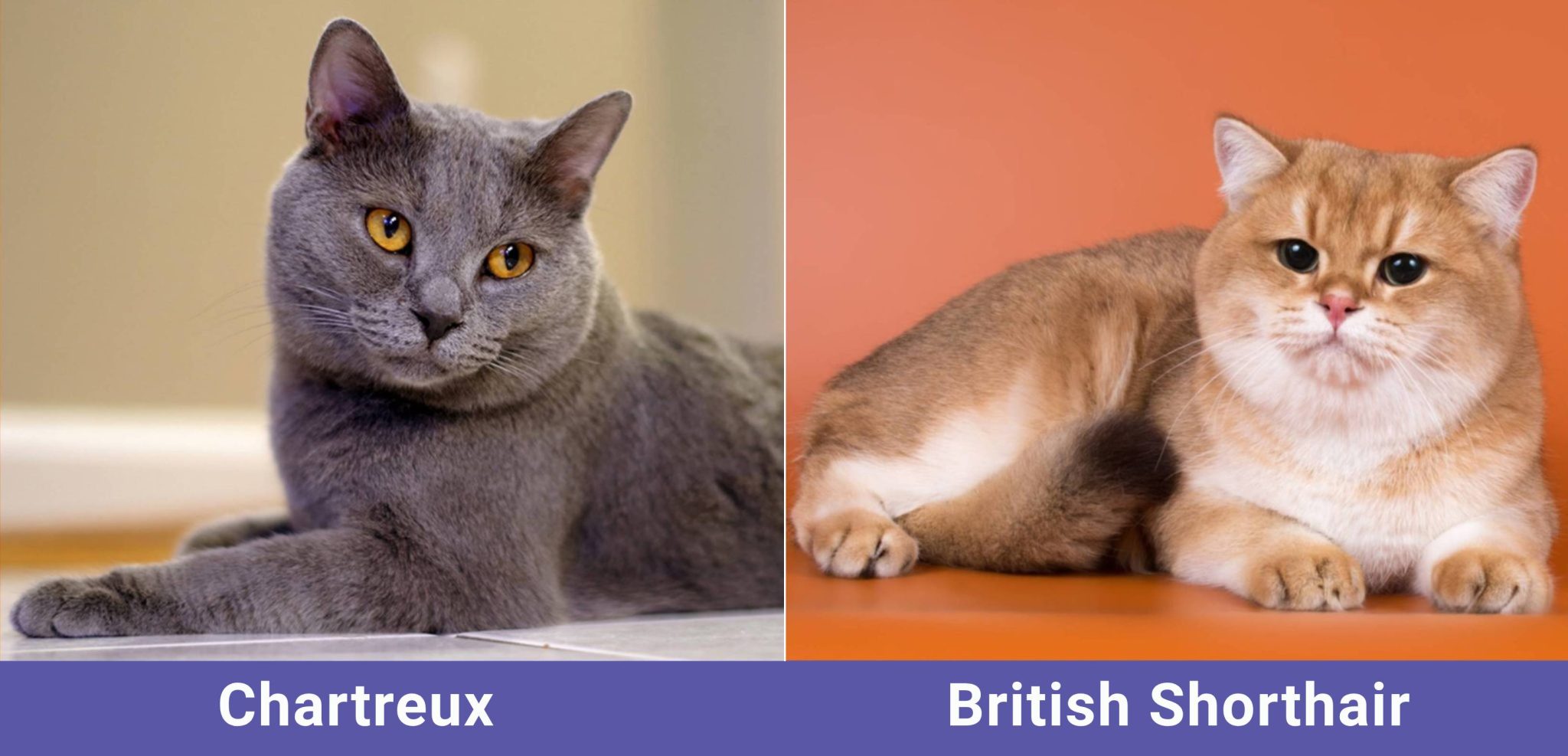
At a Glance
- Average height (adult): 12–14 inches
- Average weight (adult): 7–17 pounds
- Lifespan: 15–20 years
- Exercise: 1 hour a day
- Grooming needs: Low
- Family-friendly: Yes
- Other pet-friendly: Can be
- Trainability: Readily trainable
- Average height (adult): 9–11 inches
- Average weight (adult): 7–16 pounds
- Lifespan: 11–15 years
- Exercise: <1 hour a day
- Grooming needs: Low
- Family-friendly: Yes
- Other pet-friendly: Can be
- Trainability: Easy to train
 Chartreux Overview
Chartreux Overview
The Chartreux is a rare cat breed originating from France. An old legend says this breed descended from cats brought to France by Latin monks to live in the head monastery. But in the 1970s, the Prior of the Grande Chartreuse denied that the monastery’s archives held any evidence of such a cat existing at this time.
The first mention of the Chartreux was by George-Louis Leclerc, Comte de Buffon, a French naturalist, in the 18th century. The breed’s population was diminished during WWI, but European cat breeders made a concerted effort after the wars to prevent the Chartreux from extinction.
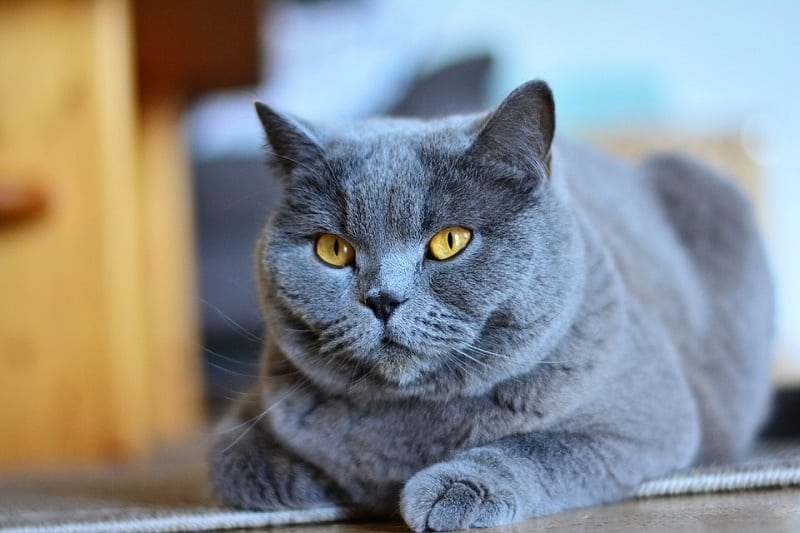
Personality
Chartreux cats are a very silent breed, with a tendency to be independent and sometimes aloof. They’re highly intelligent and love their owners, but they’re also smart enough to keep themselves entertained. It’s unlikely a Chartreux will ever give you head butts, but they’ll be a lap cat on their own terms. This breed tends to choose one person to attach themselves to.
This quiet breed barely ever makes a sound, and when they do, it’s more like a small chirping noise than a real meow. Don’t let their quiet streak fool you, though; a Chartreux is always watching its owner. In addition, their observant nature helps some cats learn to operate on/off buttons on radios or open-door latches.
This breed plays it safe with its middle-of-the-road personality. They’re not outgoing social butterflies, but they’re also not shy wallflowers either. They’re okay with strangers, provided they can introduce themselves on their own terms.
Because they have such an independent streak, the Chartreux is usually content to stay home alone while you’re at work. They get along with other cats and even dogs, though, so they won’t object to another furry companion.
Training & Exercise
Since the Chartreux is an independent cat, they don’t need to be constantly entertained by you. They’re great for cat owners who have lives outside of playing with their pets and are out of the house more than they’re in it.
Like all cats, the Chartreux enjoys a good play and climb session. In addition, their high intelligence makes puzzle toys a great investment for mental stimulation.
Because they’re so smart, Chartreux cats can be very easy to train. You can even teach them to use the toilet, jump through hoops, play fetch, and learn common commands, like sit and roll over.
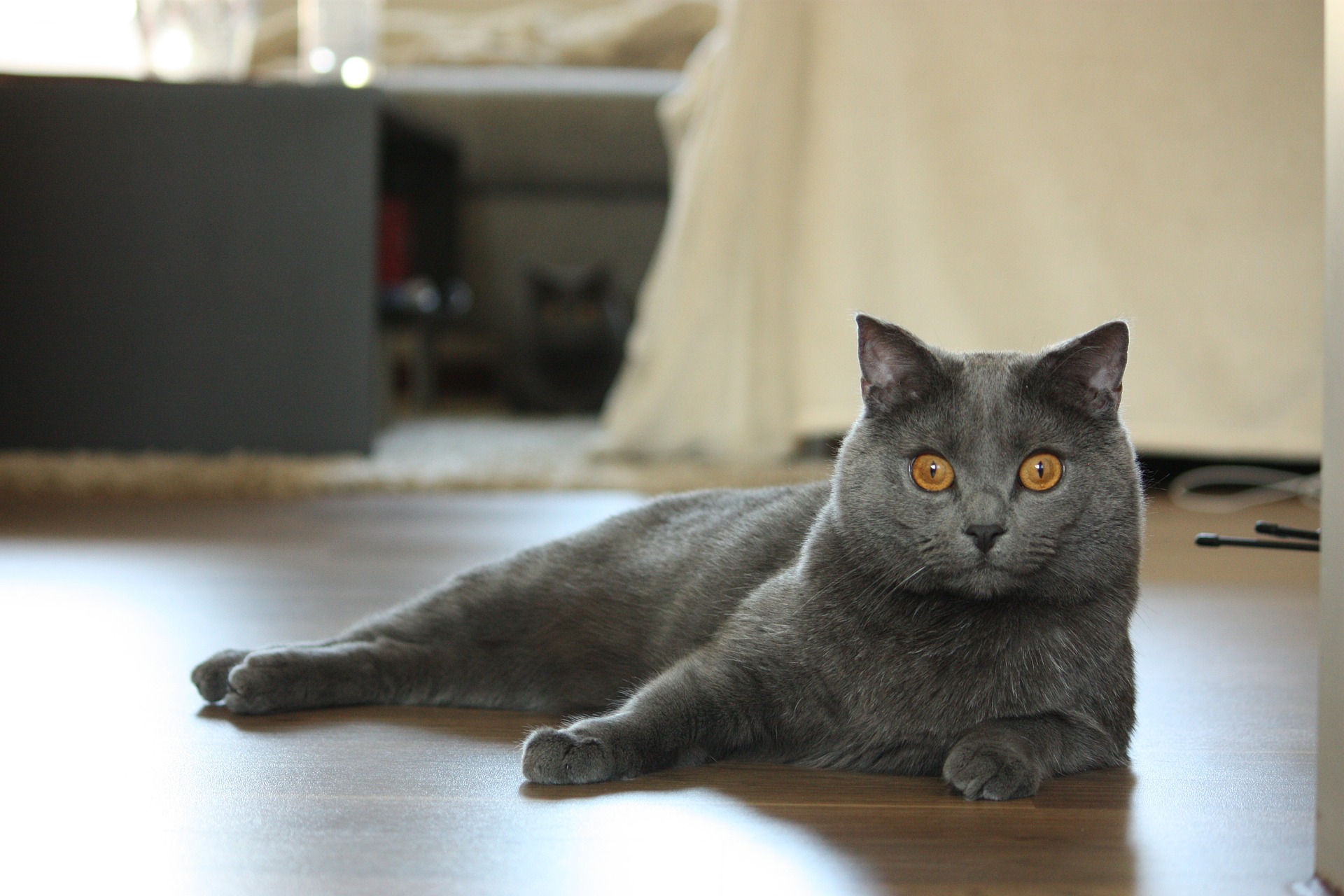
Health
Chartreux are generally healthy, but like all cat breeds, they may be susceptible to certain infections like panleukopenia, calicivirus, and rabies. Thankfully, all of these viruses are preventable through proper vaccination.
They may also be at risk of cardiomyopathy or disease of the heart muscle. The most common form of this disease is hypertrophic cardiomyopathy (HCM). HCM is the most commonly diagnosed cardiac disease in cats, occurring when the heart’s muscular walls thicken. This ultimately leads to a decrease in the heart’s efficiency and may produce other signs in the body.
According to WebMD, patellar luxation is the most common genetic disease seen in Chartreux. This occurs when your cat’s kneecap dislocates from the groove it’s supposed to sit in. It can dislocate occasionally or can become permanently dislocated.
Suitable For:
The Chartreux is suitable for pet owners who spend a lot of time outside of the home. They make great companions for families with other pets and children. Because they’re so quiet, the Chartreux can adapt to apartment living easily, and their high intelligence makes them a great fit for families who want a cat they can teach to do tricks.
 British Shorthair Overview
British Shorthair Overview
The British Shorthair has a long history dating back to the first century AD. This breed was imported by Romans who wanted felines around the camps to keep the area free from vermin and insects. Eventually, the Romans left, but the cats remained.
The modern-day British Shorthair originated in Britain thanks to Harrison Weir, a man that’s generally thought of as the first professional cat breeder. Weir took the humble British street cat and transformed it into the pedigree breed we know today. The British Shorthair population dwindled heavily after the world wars due to food shortages, but it was revived post-war by crossing Domestic Shorthairs, Russian Blues, Persians, and other breeds.

Personality
British Shorthairs make very pleasant companions. They’re easygoing, calm, and fiercely loyal to their humans and aren’t afraid to spread that loyalty amongst everyone in their family. Despite their origins as active vermin-killing cats, the modern British Shorthair is not as playful or energetic as other breeds. They have a very sweet nature and are safe to have around children and other pets.
Because of their thick fur and tendency to overheat, British Shorthairs generally don’t enjoy being picked up or carried around. They also aren’t lap cats but have their own special way of showing affection toward their humans.
This breed is independent with streaks of aloofness, but they’re still highly friendly. They can take some time warming up to new people, but they are generally gracious toward strangers.
Training & Exercise
British Shorthairs are readily trainable and fast learners. They’re easy to train, preferring puzzle games and challenging toys that can test their intellect.
They are a playful breed whose fun-loving temperament follows them well into adulthood. They’re far from athletic, with some owners even going as far as calling them clumsy. They’re not overly hyper or active, but most like a good play session with a feather wand or play mice. Like other breeds, they need access to cat trees and other cat-friendly furniture.
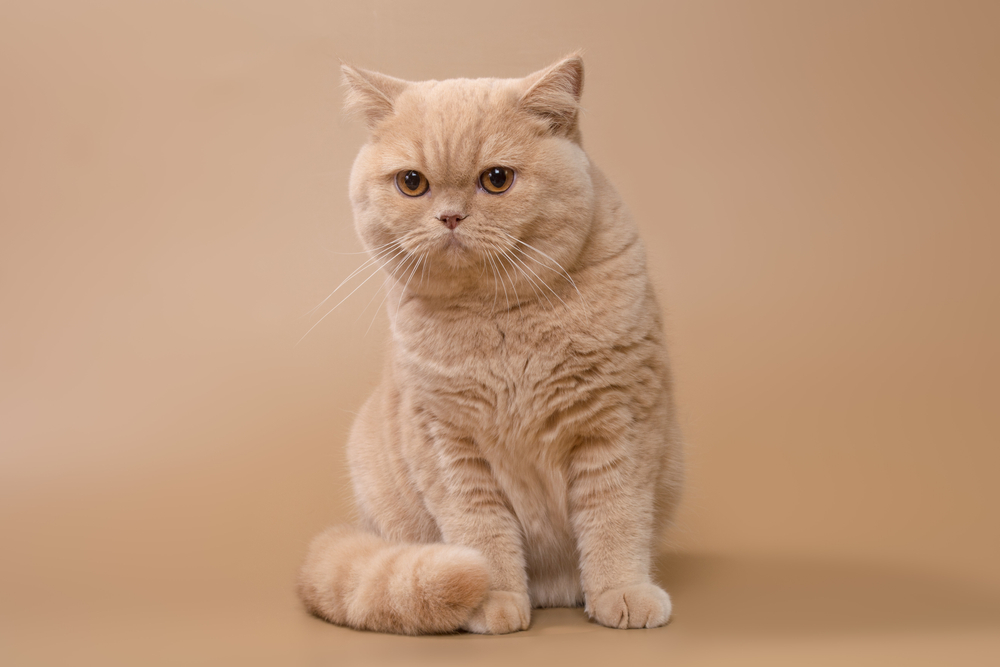
Health
British Shorthairs are a generally healthy and long-lived breed, but they may be prone to certain genetic issues.
HCM can be a problem for this breed, with studies suggesting males may be more prone to the condition.
According to The Cornell Feline Health Center, this breed may also be at high risk of polycystic kidney disease (PKD). This inherited disorder causes closed, liquid-filled sacs to develop in the kidney tissues. These sacs are cysts that can grow in size and quantity, eventually affecting normal kidney function.
British Shorthairs must be fed carefully, as they’re also prone to obesity. Since they’re not especially active, most don’t get the opportunity for exercise that other breeds do. This means you’ll need to watch their weight and food intake to ensure they stay healthy.
Suitable For:
The British Shorthair is the perfect companion for households looking for a cat that’s affectionate but not overly needy. They like people and are great for households with kids and other pets. They don’t want to be handled roughly, so owners with small children need to teach their kids gentleness and boundaries.
 Which Breed Is Right for You?
Which Breed Is Right for You?
While Chartreux and British Shorthairs are similar in appearance, they have some traits that set them apart.
The Chartreux is a smaller cat with a shorter lifespan. They’re very active and affectionate, often engaging in “dog-like” activities like fetch. They’re highly intelligent and observant, making them mischievous master escape artists. Chartreux cats tend to prefer one family member and are known for their silence.
British Shorthairs tend to be more aloof and independent. This isn’t to say they’re not loyal and loving, however. They care deeply for their family members and aren’t loyal to just one person. British Shorthairs are much larger than the Chartreux, so owners will need bigger accessories to accommodate their size.
Deciding which breed is best for you will depend on what you want in a feline companion. Do you want an affectionate, intelligent, mischievous, and playful kitty? The Chartreux might be right up your alley. The British Shorthair might be better if you prefer an independent cat that quietly dotes on you.
You’re going to have a beautiful, affectionate, and loyal kitty, no matter which breed you ultimately decide is best.
Featured Image Credit: Left – LucasBouillon, Pixabay | Right – PHOTOCREO Michal Bednarek, Shutterstock

